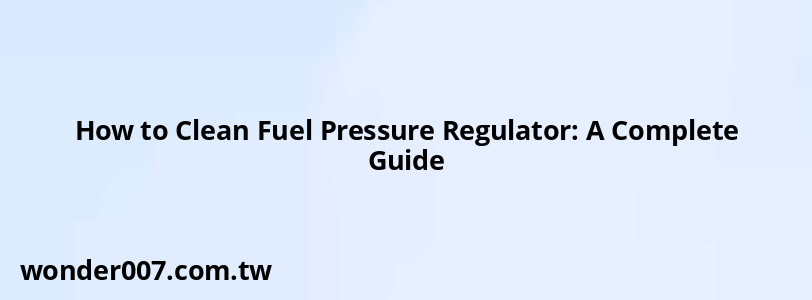How to Clean Fuel Pressure Regulator: A Complete Guide

Cleaning your fuel pressure regulator is essential for maintaining your vehicle’s performance and efficiency. A clean regulator ensures that the fuel system operates smoothly, preventing issues like rough idling or poor fuel economy. This guide provides a detailed, step-by-step process for cleaning your fuel pressure regulator effectively.
Understanding the Fuel Pressure Regulator
The fuel pressure regulator is a crucial component of your vehicle's fuel system. It maintains the correct fuel pressure for optimal engine performance. Over time, dirt and debris can accumulate in the regulator, leading to performance issues. Regular cleaning can help prevent these problems and extend the life of the component.
Tools and Materials Needed
Before starting the cleaning process, gather the following tools and materials:
Required Tools
- Screwdriver set
- Wrench set
- Socket set
- Fuel pressure gauge
- Compressed air can
Necessary Cleaning Supplies
- Carburetor cleaner or fuel system cleaner
- Soft brushes (to avoid damage)
- Lint-free cloths
- Catch pan (to collect any spills)
- New O-rings and gaskets (if needed)
Step-by-Step Cleaning Process
1. Preparation
- Ensure the engine is cool to prevent burns.
- Disconnect the negative battery terminal to avoid electrical hazards.
- Relieve fuel system pressure by removing the fuel pump fuse and running the engine until it stalls.
2. Accessing the Regulator
- Locate the fuel pressure regulator on the fuel rail.
- Carefully document all connections and orientation for reassembly.
- Disconnect the vacuum line and fuel lines (use a catch pan to collect any spilled fuel).
- Remove any mounting bolts securing the regulator.
3. Initial Inspection
- Check for visible damage or heavy contamination.
- Inspect O-rings and seals for wear.
- Document any unusual wear or damage.
4. Cleaning Procedure
- External Cleaning: Spray the exterior of the regulator with carburetor cleaner and wipe it down with a lint-free cloth.
- Internal Cleaning: Use compressed air to blow out any debris from the fuel ports and vacuum passages. Avoid using harsh chemicals that could damage internal components.
5. Reassembly
- Replace all O-rings and ensure proper alignment of components.
- Secure all connections tightly to prevent leaks.
- Reconnect the vacuum line and fuel lines.
6. Testing
- Reconnect the battery terminal.
- Restore fuel pressure by reinserting the fuel pump fuse and turning on the ignition without starting the engine.
- Check for leaks around connections before starting the engine.
- Start the engine and monitor its performance, ensuring steady fuel pressure with a gauge.
Benefits of Cleaning Your Fuel Pressure Regulator
Regular cleaning of your fuel pressure regulator can lead to significant benefits:
- Improved engine operation with smoother idling and better acceleration.
- Enhanced fuel efficiency, potentially saving you money on gas.
- Extended lifespan of components within your vehicle's fuel system.
FAQs About Fuel Pressure Regulator Cleaning
- How often should I clean my fuel pressure regulator?
It is recommended to clean it every 30,000 miles or as needed based on performance issues. - Can I clean it without removing it?
While some surface cleaning is possible, thorough cleaning requires removal for access to all components. - What signs indicate a dirty regulator?
Symptoms include poor acceleration, rough idling, or fluctuating fuel pressure.
By following this guide, you can effectively clean your fuel pressure regulator, ensuring optimal performance for your vehicle. Regular maintenance not only enhances efficiency but also prevents costly repairs down the line.
Related Posts
-
2007 Chevy Trailblazer Dashboard Warning Lights Guide
26-01-2025 • 127 views -
Starter for a 2003 Chevy Impala: Comprehensive Guide
29-01-2025 • 161 views -
2006 Honda Civic Serpentine Belt Routing Guide
26-01-2025 • 123 views -
GMC Envoy Years to Avoid: Buyer's Guide
26-01-2025 • 314 views -
Honda Odyssey Serpentine Belt Tensioner: Replacement Guide
27-01-2025 • 131 views
Latest Posts
-
Rear Brake Caliper Piston Won't Compress
01-02-2025 • 315 views -
2015 Chevy Traverse AC Recharge Port Location
01-02-2025 • 366 views -
Are O2 Sensors Covered Under Warranty
01-02-2025 • 339 views -
Power Steering Fluid Leak On Passenger Side
01-02-2025 • 420 views -
How To Turn Off Paddle Shifters Mercedes
01-02-2025 • 335 views
Popular Posts
-
Power Steering and ABS Light On: Causes and Solutions
27-01-2025 • 613 views -
Hino Warning Lights: Understanding Dashboard Alerts
26-01-2025 • 635 views -
V12 Engine Costs: What You Need to Know
26-01-2025 • 633 views -
EPC Warning Light: What It Means for Your Vehicle
27-01-2025 • 591 views -
EPC Light: Understanding Causes and Solutions
26-01-2025 • 1019 views
